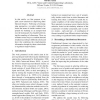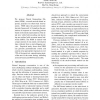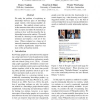ACL
2015
8 years 7 months ago
2015
We present MultiGranCNN, a general deep learning architecture for matching text chunks. MultiGranCNN supports multigranular comparability of representations: shorter sequences in ...
ACL
2015
8 years 7 months ago
2015
In this article, we first propose to exploit a new criterion for improving distributional thesauri. Following a bootstrapping perspective, we select relations between the terms o...
ACL
2015
8 years 7 months ago
2015
Human labeled corpus is indispensable for the training of supervised word segmenters. However, it is time-consuming and laborintensive to label corpus manually. During the process...
ACL
2015
8 years 7 months ago
2015
We propose Neural Responding Machine (NRM), a neural network-based response generator for Short-Text Conversation. NRM takes the general encoderdecoder framework: it formalizes th...
ACL
2015
8 years 7 months ago
2015
We study the problem of explaining relationships between pairs of knowledge graph entities with human-readable descriptions. Our method extracts and enriches sentences that refer ...
ACL
2015
8 years 7 months ago
2015
Current distributed representations of words show little resemblance to theories of lexical semantics. The former are dense and uninterpretable, the latter largely based on famili...
ACL
2015
8 years 7 months ago
2015
In this paper, we propose a general framework to incorporate semantic knowledge into the popular data-driven learning process of word embeddings to improve the quality of them. Un...
ACL
2015
8 years 7 months ago
2015
The inability to model long-distance dependency has been handicapping SMT for years. Specifically, the context independence assumption makes it hard to capture the dependency bet...
ACL
2015
8 years 7 months ago
2015
ACL
2015
8 years 7 months ago
2015
In order to build psycholinguistic models of processing difficulty and evaluate these models against human data, we need highly accurate language models. Here we specifically co...



